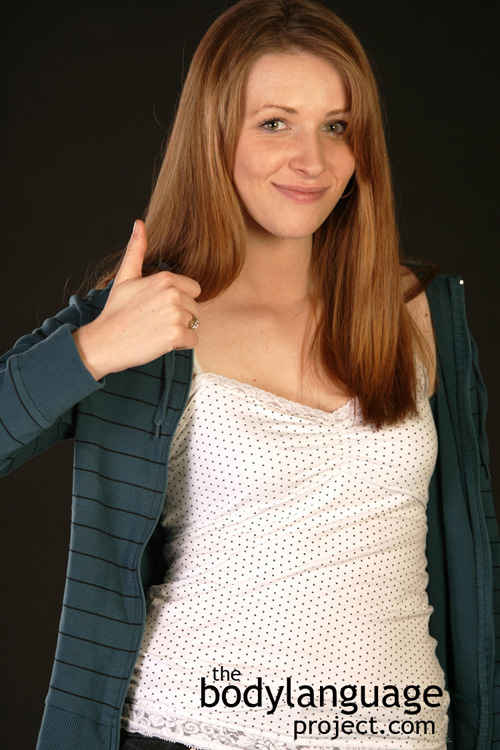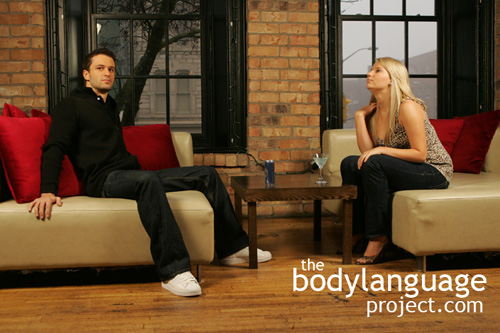Body Language of Unkept or Dowdiness
Synonym(s): Rumpled, Sloppy Dress, Dowdiness, Un-groomed, Rumpled Appearance.
Description: A nonverbal term referring to a person’s dress that is wrinkled but otherwise fairly clean, shapeless, outdated, bland, messy, unflattering, out-of-date, out of style and well worn. When a person lacks attention to personal care, cleanliness, rumpled, dirty, or un-kept attire, unwashed body or hair or malodor. It may include clothing that is far too casual for the occasion.
In One Sentence: Being unkept is can be a sign of many underying factors including a low socioeconomic background, that a person is artistic, intellectual or is an absent minded thinker, is preoccupied, sloppy, un-caring of his impression and at worst, dirty and unpopular.
How To Use it: Being unkept is a negative nonverbal signal and should be avoided in almost every situation. Even in the comfort of one’s own home, where it is likely to receive the most tolerance, being dowdy remains a poor reflection of the mind.
Married couples can suffer from overall dowdiness which only drags down romance further. Being unkept says two things. One, that a person is comfortable in their relationship and is not concerned about their outer appearance, and two, that, one is not concerned about the impression they are making in their counterparts. Unfortunately, these are two conflicting messages, which, if not remedied, can create resentment. One should be particularly conscious of situations where one dresses-up for work but quickly down-dresses after work. This tells your partner that the impression you make in others is more important than the impression you make in them. This might work sufficiently in friendships, however, looking ones best is highly important in intimate relationships.
In business, one should always be cognizant of making a good overall outer impression and this includes a lack of dowdiness. While it is moderately tolerated by acquaintances, friends and partners, one is unlikely to receive the benefit of the doubt in more day-to-day encounters.
Overall, however, if you wish to create and maintain positive impressions, avoid dressing dowdy as no positive attributes are universally realized from this condition.
Context: General.
Verbal Translation: “I’m clean, but my mind is too busy to care about how I look on the outside. I value my thoughts over my clothing and don’t care to be judged on my outside appearance. That’s why I permit my clothing to be outdated and sloppy.” “I’m suffering from mental illness or depression, that is weighing me down which is why I lack basic motivation required to keep my body clean and clothing presentable.”
Variant: See Grooming and Preening.
Cue In Action: a) The professor was brilliant and creative, but his clothing hung off of him, it was outdated and nothing matched. While his student respected him for his thoughts, they rated him poorly on character. b) The teenager kept his room in an un-kept state that blew over to his physical appearance and clothing. He habitually wore jogging pants and a soiled shirt and barely fed himself proper meals. He habitually lazed around the house, waking at noon or later. His parents feared that he had fallen into depression.
Meaning and/or Motivation: Being un-kept with poor fashion signifies a low socioeconomic background, that a person is artistic, intellectual or is an absent minded thinker, is preoccupied, sloppy, un-caring of his impression and at worst dirty and unpopular.
Preening includes anything done to maintain our physical appearance such as fixing our hair, washing our bodies, wearing clean, matching clothing, brushing our teeth and so forth. In an evolutionary context, preening signifies that we are healthy and in a good state of mind.
It has been noted around the world that when people suffer from illness personal grooming is usually one of the first aspects he or she neglects. When minds are busy with more pressing matters it quickly turns away from personal hygiene. Homeless people and the severely depressed will wear un-kept hair, dirty clothing and ignore showering. They will lie around for hours on end but when they do finally take foot, their posture will be slumped, shoulders rolled inward, torsos bent at the waste and their head will droop as if they carry the “weight of the world upon their shoulders.” They will succumb to the forces of gravity rather than defy it such as what we see with the exuberant that seem to have a “bounce in their step.” This is why it is so vitally important to keep a well cared for appearance to signal to others that we have proper mental health (unless you can get away with it!). A lot can be surmised about a person from wearing torn and soiled clothing, especially in public. Like manners, preening tells others that we respect their thoughts and opinions, and that we wish to belong to a functioning society.
In other cases, an un-kept appearance serves to illustrate that a person does not wish to conform to societal norms and is not seeking approval from the culture at large. We may see this in fringe groups such as feminist who keep hairy legs and arm pits. There are other subgroups such as “nerds” who are social outcasts who will choose comfortable clothing over stylish clothing. Some people are also not attuned to the societal norms at all and keep a rather laissez-faire approach to their upkeep. How one maintains their appearance give us clues to their overall thoughts and beliefs.
Cue Cluster: Someone who is dowdy in dress will usually have other odd characteristics of manner. They might be social awkward, use highbrow humour or humour that is dry, commit other social faux pas like encroaching on other people and lack good eye contact. As this cue can signal degrees of mental illness, be watchful for additional cues to decide on its relevance. A general malaise might be low level and only result in an un-kept room, or body odor, but might spill over to general attire, grooming, mismatched clothing, overly casual or dirty clothing. When this spills over to bad body language such as slumped shoulders, expressionless faces, unsmiling, lack of affect, lazy appearance, cowering and desire for isolation, this can spell more serious matters such as full blown mental illness.
Body Language Category: Adornments, Arrogance or arrogant body language, Depressive, Low confidence body language.
Resources:
Allen, Sarah J. ; Kramer, Jack J. Modification of personal hygiene and grooming behaviors with contingency contracting: A brief review and case study. Psychology in the Schools. 1990. 27(3): 244-251.
Buckley, Hilda Mayer ; Roach, Mary Ellen. Clothing as a Nonverbal Communicator of Social and Political Attitudes. Home Economics Research Journal. 1974 3(2): 94-102.
Cantor, Michael B. ; Smith, Stephen E. ; Bryan, Bonita R. Induced bad habits: Adjunctive ingestion and grooming in human subjects. Appetite. 1982. 3(1): 1-12.
Curtis, V., & Biran, A. (2001). Dirt, disgust, and disease: Is hygiene in our genes? Perspectives in biology and medicine, 44(1), 17–31.
Conti, Richard P ; Conti, Melanie A. Mock jurors’ perceptions of facial hair on criminal offenders. Perceptual and motor skills. 2004 98:(3 Pt 2): 1356-8
Cash, T. F., Dawson, K., Davis, P., Bowen, M., & Galumbeck, C. (1989). Effects of cosmetics use on the physical attractiveness and body image of American college women. Journal of Social Psychology, 129, 349-355.
http://bodylanguageproject.com/articles/science-makeup-how-to-use-it/
Chao, A., & Schor, J. B. (1998). Empirical tests of status consumption: Evidence from women’s cosmetics. Journal of Economic Psychology, 19, 107-131.
Franzoi, S. L. (2001). Is female body esteem shaped by benevolent sexism? Sex Roles, 44, 177-188.
Cornelis, Erlinde ; Cauberghe, Verolien ; De Pelsmacker, Patrick. Being healthy or looking good? The effectiveness of health versus appearance-focused arguments in two-sided messages. Journal of Health Psychology. 2014. 19(9): 1132-1142.
de Waal, F. (1997). The chimpanzee’s service economy: Food for grooming. Evolution & Human Behavior, 18, 375–386.
De Souza, Altay Alves Lino ; Baião, Vera Baumgarten Ulyssea ; Otta, Emma. Perception of men’s personal qualities and prospect of employment as a function of facial hair. Psychological reports. 2003. 92(1): 201-8.
Dunbar, R. (1996). Grooming, gossip and the evolution of language. London: Faber and Faber.
Das, Jayoti ; De Loach, Stephen B. Mirror, mirror on the wall: The effect of time spent grooming on earnings. Journal of Socio-Economics. 2011. 40(1): 26-34.
Erdos, Diane. Look good … feel better – a program for cancer patients. (personal grooming program) (Patient’s Advocate) (Column). RN. 1992. 55(10): 25(3).
Etcoff, Nancy L ; Stock, Shannon ; Haley, Lauren E ; Vickery, Sarah A ; House, David M Suzuki, Satoru (Editor). Cosmetics as a Feature of the Extended Human Phenotype: Modulation of the Perception of Biologically Important Facial Signals (Cosmetics: Feature of the Extended Human Phenotype). PLoS ONE. 2011. 6(10): p.e25656.
French, M.T., Robins, P.K., Homer, J.F., Tapsell, L.M., 2009. Effects of physical attractiveness, personality, and grooming on academic performance in high school.
Labour Economics 16, 373–382.
Greenfield, Paige. Can you fake a prettier face?(hairstyles)(Report). Women’s Health. 2010: 036.
Grammer, Karl ; Moller, Anders P. ; Fink, Bernhard ; Manning, John T. Physical attractiveness and health: comment on Weeden and Sabini (2005).(Author Abstract). Psychological Bulletin. 2005. 131(5): 658(4).
Girard, Jeffrey M.; Jeffrey F. Cohna; Mohammad H.Mahoor S.; Mohammad Mavadati;
Zakia Hammal; and Dean P. Rosenwalda. Nonverbal Social Withdrawal In Depression: Evidence From Manual And Automatic Analyses. Image and Vision Computing. 2013.
http://bodylanguageproject.com/articles/body-language-signals-withdrawal-depression
Greenless, Iain ; Buscombe, Richard ; Thelwell, Richard ; Holder, Tim ; Rimmer, Matthew. Impact of opponents’ clothing and body language on impression formation and outcome expectations. Journal of Sport & Exercise Psychology. 2005 27(1): 39-52.
Hosey, Geoffrey ; Thompson, Robin. Grooming and touching behaviour in captive ring-tailed lemurs ( Lemur catta L.). Primates. 1985. 26(1): 95-98.
Hazan, C., & Shaver, P. (1987). Romantic love conceptualized as an attachment process. Journal of Personality and Social Psychology, 52, 511–524.
Hellström, A., & Tekle, J. (1994). Person perception through facial photographs: Effects of glasses, hair, and beard on judgments of occupation and personal qualities. European Journal of Social Psychology, 24, 693–705. doi 10.1002/ejsp.2420240606
Hinsz, V. B., D. C. Matz, and R. A. Patience 2001 Does Women’s Hair Signal Reproductive Potential? Journal of Experimental Social Psychology 37:166-172.
Hintikka, Pirjo ; Saarinen, Antti ; Tanskanen, Heli ; Koivumaa-honkanen, Heimo ; Viinamäki, Heimo. Gender differences in living skills and global assessment of functioning among outpatients with schizophrenia. Australian and New Zealand Journal of Psychiatry. 1999. 33(2): 226-231.
Hoover, Kelli ; Grove, Michael ; Gardner, Matthew ; Hughes, David P ; Mcneil, James ; Slavicek, James. A gene for an extended phenotype. Science. 2011. 333(6048): 1401.
Hamermesh, D.S., Biddle, J.E., 1994. Beauty and the labor market. American Economic
Review 84 (5), 1174–1194.
Hamermesh, D.S., Meng, D., Zhang, J., 2002. Dress for success – does primping pay?
Labor Economics 9, 361–373.
Ingmanson, E. Cultural transmission of a communicative gesture in a captive group of bonobos (Pan paniscus).(Abstract). American Journal of Physical Anthropology. 2002. 117(4): 88(1).
Karl, Katherine A. ; Hall, Leda Mcintyre ; Peluchette, Joy V. City employee perceptions of the impact of dress and appearance: you are what you wear. Public Personnel Management. 2013 42(3): 452(19).
Kinzey, W., & Wright, P. (1982). Grooming behavior in the titi monkey, Callicebus torquatos. American Journal of Primatology, 3, 267–275.
Koonin, Marc A. Avoiding claims of discrimination based on personal appearance, grooming, and hygiene standards. The Labor Lawyer. 1999. 15(1): 19-45.
Langlois, J.H., Kalakanis, L., Rubenstein, A.J., Larson, A., Hallam, M., Smoot, M., 2000.
Lihi Segal-Caspi, Sonia Roccas, and Lilach Sagiv. Don’t Judge A Book By Its Cover, Revisited: Perceived And Reported Traits And Values Of Attractive Women. Psychological Science, 2012; 23(10): 1112-1116.
http://bodylanguageproject.com/articles/are-attractive-women-worthy-of-their-physical-appearance-or-does-the-book-not-read-like-its-cover/
Malatynska, E.,Knapp,R.J.,2005.Dominant-Submissive Behavior as Models of Mania and Depression. NeuroScience and.Biobehavior .Rev.29(4–5): 715–737, http://dx.doi.org/10.1016/j.neubiorev.2005.03.014.
Mulhern, R., Fieldman, G., Hussey, T., Le´veˆque, J.-L., & Pineau, P. (2003). Do cosmetics enhance Caucasian female facial attractiveness? International Journal of Cosmetic Science, 25(4), 199-205.
http://bodylanguageproject.com/articles/beauty-eye-holder-makeup/
Mesko, Norbert ; Bereczkei, Tamas. Hairstyle as an adaptive means of displaying phenotypic quality. Human Nature. 2004. 15(3): 251-270.
Maxims ormyths of beauty? ameta-analytic and theoretical review. Psychological Bulletin 126 (3), 390–423.
Mobius, M.M., Rosenblat, T.S., 2006. Why beauty matters. American Economic Review 96 (1), 222–235.
Mccoy, Lee. First impressions. (projecting a professional image)(includes related article on casual Fridays). Canadian Banker. 1996. 103(5): 32(4).
Nelson, Holly ; Geher, Glenn. Mutual Grooming in Human Dyadic Relationships: An Ethological Perspective. Current Psychology. 2007. 26(2): 121-140.
Peak, S.L., 1986. Effects of garment styles on the perceptions of personal traits. Clothing and Textiles Research Journal 5 (1), 26–29.
Rempel, J., Holmes, J., & Zanna, M. (1985). Trust in close relationships. Journal of Personality and Social Psychology, 49, 95–112.
Shimooka, Yukiko ; Nakagawa, Naofumi. Functions of an unreported “rocking-embrace” gesture between female Japanese Macaques ( Macaca fuscata ) in Kinkazan Island, Japan. Primates. 2014. 55(2): 327-335.
Sturman, Edward D. Invluntary Subordination and Its Relation to Personality, Mood,
and Submissive Behavior. Psychological Assessment. 2011. 23(1): 262-276 DOI: 10.1037/a0021499
http://bodylanguageproject.com/articles/nonverbal-submission-men-women-depression-critical-examination-use-disuse-submission/
Stylish Hard Bodies Branded Masculinity in Men’s Health Magazine. Alexander, Susan M. Sociological Perspectives. 2003. 46(4): 535-554.
Tinlin, Rowan M. ; Watkins, Christopher D. ; Welling, Lisa L. M. ; Debruine, Lisa M. ; Al – Dujaili, Emad A. S. ; Jones, Benedict C. Perceived facial adiposity conveys information about women’s health.(Report). British Journal of Psychology. 2013. 104(2): 235(14).
Thompson, Kristin. Grooming the Naked Ape: Do Perceptions of Disease and Aggression Vulnerability Influence Grooming Behaviour in Humans? A Comparative Ethological Perspective. Current Psychology. 2010. 29(4): 288-296.
Teixeira Fiquer, Juliana; Paulo Sérgio Boggio and Clarice Gorenstein. Talking Bodies: Nonverbal Behavior in the Assessment of Depression Severity. Journal of Affective Disorders. 2013. 150: 1114-1119.
http://bodylanguageproject.com/articles/using-nonverbal-behaviour-to-assess-depression-severity/
Vartanian, Lenny R. ; Wharton, Christopher M. ; Green, Erica B. Appearance vs. health motives for exercise and for weight loss. Psychology of Sport & Exercise. 2012. 13(3): .251-256.
Wasylkiw, L. ; Emms, A.A. ; Meuse, R. ; Poirier, K.F. Are all models created equal? A content analysis of women in advertisements of fitness versus fashion magazines. Body Image. 2009. 6(2): 137-140.
Worrall, Norman ; Taylor, Vanessa M. ; Ricketts, Jennifer P. ; Jones, Ann P. Personal Hygiene Cues In Impression Formation. Perceptual and Motor Skills. 1974. 38(3c): 1269-1270.
Wachtmeister, C. (2001). Display in monogamous pairs: A review of empirical data and evolutionary explanations. Animal Behaviour, 61(5), 861–868.
Wilkinson, G. S. (1986). Social grooming in the common vampire bat, Desmodus rotundus. Animal Behaviour, 34(6), 1880–1889.
Wax, M., 1957. Themes in cosmetics and grooming. The American Journal of Sociology
62 (6), 588–593.











